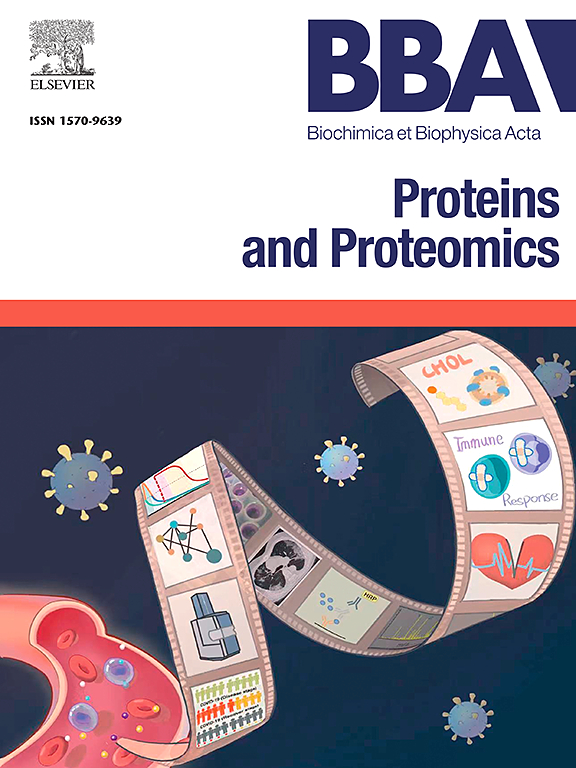Participation of a cysteine tetrad in the recycling mechanism of methionine sulfoxide reductase A from radiation-tolerant Deinococcus bacteria
IF 2.3
4区 生物学
Q3 BIOCHEMISTRY & MOLECULAR BIOLOGY
Biochimica et biophysica acta. Proteins and proteomics
Pub Date : 2025-02-08
DOI:10.1016/j.bbapap.2025.141063
引用次数: 0
Abstract
Methionine oxidation leads to the formation of methionine sulfoxide (MetO), which is reduced back to Met by methionine sulfoxide reductases (Msrs). The catalytic mechanism used by A-type Msr (MsrA) for MetO reduction requires a catalytic cysteine (Cys), which is converted to a sulfenic acid. In general, two resolving Cys are required for the regeneration of the catalytic Cys forming two consecutive disulfide bridges, the last one being efficiently reduced by thioredoxin (Trx). Here, we performed the biochemical characterization of MsrA from Deinococcus deserti. It possesses four Cys, two present in the active site motif (18 and 21) and two distal ones (53 and 163). We produced MsrA variants mutated for these cysteines and analyzed their capacity to reduce MetO in the presence of the NADPH-Trx reductase/Trx system, their ability to form heterodimers with Trxs, and their redox status after incubation with MetO. We show that all four Cys are involved in the regeneration process of enzyme activity by Trx. After MetO reduction by Cys18, a first disulfide bridge is formed with Cys21. A second disulfide involving Cys21 with either Cys53 or Cys163 is reduced by Trx, and a third Cys53-Cys163 disulfide can be formed and also reduced by Trx. These findings highlighting for the first time the involvement of a Cys tetrad in the catalytic and regeneration mechanisms for a MsrA are placed in a structural context by performing 3D modelling and discussed in relation to the known recycling mechanisms involving a Cys triad.

半胱氨酸四分体参与耐辐射球菌甲硫氨酸亚砜还原酶a的循环机制。
蛋氨酸氧化会形成蛋氨酸亚砜(MetO),蛋氨酸亚砜还原酶(Msrs)会将其还原成蛋氨酸。A 型 Msr(MsrA)还原 MetO 的催化机制需要一个催化半胱氨酸(Cys),并将其转化为亚硫酸。一般来说,催化半胱氨酸的再生需要两个解析半胱氨酸,形成两个连续的二硫桥,最后一个被硫代氧化还蛋白(Trx)有效还原。在这里,我们对沙漠化德氏球菌的 MsrA 进行了生化鉴定。它拥有四个 Cys,其中两个位于活性位点图案中(18 和 21),另外两个位于远端(53 和 163)。我们制作了这些半胱氨酸突变的 MsrA 变体,并分析了它们在 NADPH-Trx 还原酶/Trx 系统存在下还原 MetO 的能力、与 Trxs 形成异二聚体的能力以及与 MetO 培养后的氧化还原状态。我们发现,所有四个 Cys 都参与了 Trx 的酶活性再生过程。Cys18 还原 MetO 后,与 Cys21 形成第一个二硫桥。涉及 Cys21 与 Cys53 或 Cys163 的第二个二硫化物会被 Trx 还原,第三个 Cys53-Cys163 二硫化物也会形成并被 Trx 还原。这些发现首次强调了 Cys 四元组在 MsrA 催化和再生机制中的参与,并通过三维建模将其置于结构背景中,同时结合已知的涉及 Cys 三元组的循环机制进行了讨论。
本文章由计算机程序翻译,如有差异,请以英文原文为准。
求助全文
约1分钟内获得全文
求助全文
来源期刊
CiteScore
8.00
自引率
0.00%
发文量
55
审稿时长
33 days
期刊介绍:
BBA Proteins and Proteomics covers protein structure conformation and dynamics; protein folding; protein-ligand interactions; enzyme mechanisms, models and kinetics; protein physical properties and spectroscopy; and proteomics and bioinformatics analyses of protein structure, protein function, or protein regulation.

 求助内容:
求助内容: 应助结果提醒方式:
应助结果提醒方式:


